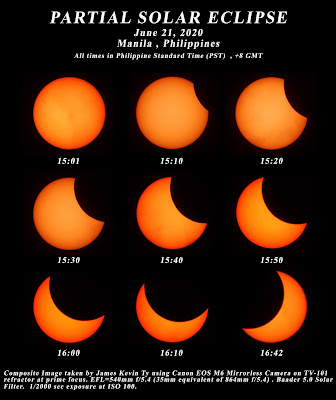The sky this evening is clear so me and my son setup our Borg 76ED refractor mounted on Vixen Porta 2 mount to image the last Full Moon for the year 2020. I use a Canon EOS M6 mirrorless camera with Borg 76ED refractor to image it with 1/1250sec exposure at ISO 100.
Wednesday, December 30, 2020
Tuesday, December 29, 2020
Solar Imaging Session - December 30, 2020
The sky this morning is partly clear but I was able to setup my Borg 76ED refractor with ZWO ASI120mm mini on Vixen GPDX mount to image the 2 sunspot groups namely AR2894 and 2795 despite having trouble with mount tracking problem which I later diagnosed to be a bad battery power output of less than 10.5V even after recharging it. Nevertheless, I'm still happy to get probably my lat solar image for the year 2020. I was only able to image in white light because of the tracking problem as well as cloud cover.
Wednesday, December 23, 2020
December 23, 2020 Jupiter Saturn Great Conjunction
As expected, the weather this evening is almost clear and together with my son KC, we were able to image again the Jupiter and Saturn Great Conjunction. The separation is now slightly a bit farther than the past 2 days and this will probably be my last documentation of this conjunction.
I initially use my Borg 76ED refractor with Canon EOS M6 mirrorless camera at prime focus of 500mm f/6.5 to image the event but seeing the weather is a bit forgoing, we opted to switch to the Celestron C90 Maksutov-Cassegrain with an effective focal length of 1350mm f/13.8 on the Canon EOS M6 mirrorless camera to get more amplification and it was again mounted on my old reliable Vixen GPDX mount.
Wide field image was taken using Huawei P40 Pro at 27mm (35mm equivalent) at f/1.9 with 1/20 sec exposure at ISO 3200. Close up were taken using Celestron C90 Maksutov-Cassegrain with an effective focal length of 1350mm f/13.8 on the Canon EOS M6 mirrorless camera at 1/30 sec exposure at ISO 800 while the overexposed Saturn and Jupiter with Jovian Moons were exposed at 1/8 sec exposure at ISO 800.
Tuesday, December 22, 2020
December 22, 2020 Jupiter Saturn Great Conjunction
The sky today was very cloudy and honestly, I didn't have plans to do any imaging of the conjunction as it looks very impossible to get any shot at all. But after I got home at 5:30pm, I look out of our house window and some possible cloud breakup where Jupiter and Saturn are located so I quickly setup my Borg 76ED refractor with Canon EOS M6 mirrorless camera mounted on Vixen GPDX mount and patiently waits. As soon as I saw the 2 planets from my wide field shot at 6:03pm from my Huawei P40 Pro at 27mm (35mm equivalent) at f/1.9 on 1/20 sec exposure at ISO 2500, I quickly fired away a few shots before clouds started to interfere again. Images was taken at prime focus of Borg 76ED refractor at 500mm f/6.5 at 1/30sec at ISO 800 while the one showing overexposed Jupiter with Jovian Moons and Saturn ere taken at 1/2 sec exposure at ISO 1600.
Monday, December 21, 2020
December 21, 2020 Jupiter Saturn Great Conjunction
The sky this evening is very cloudy and actually I already lose hope of seeing it as today is the closest separation between planet Jupiter and Saturn with less than 0.6 deg apart.
Actually, I started to wait for clearing since 5:45pm and I only was able to get a glimpse of then first with my Huawei P40 Pro smartphone at 6:51 pm with a low altitude of 11 degrees! I got to snap it at 27mm focal length (35mm equivalent) at f/1.9 1/17 sec at ISO 4000. I also tried to image it through the Borg 76ED refractor at 500mm f/6.5 prime focus at 1/3 sec at ISO 3200. The image is already muddy at less than 10 degrees but I can still see Jupiter and Saturn obviously. Sometimes, astronomy is a test of patience as the time you spend waiting for the clouds to open up might not come out successfully.
Nevertheless I'm still happy to capture them despite the worst condition that I had. Hope to capture it tomorrow at a higher altitude and better weather.
Wednesday, December 16, 2020
December 16, 2020 Jupiter Saturn Crescent Moon Great Conjunction
The sky this evening is clear and the beautiful pair of Jupiter and Saturn are joined by the lovely Crescent Moon with Earthshine lying low in the western horizon. Image taken using Huawei P40 Pro at 27mm (35mm equivalent) f/1.9 at 1/17 sec at ISO 3200.
Monday, December 14, 2020
December 13, 2020 Jupiter Saturn Great Conjunction
The sky this evening is again hazy but Jupiter and Saturn are still visible in the western sky as they continue to get closer each day till its peak of Dec 21 where they will just be separated by 0.1 deg only. Taken using Huawei P40 Pro at 27mm f/1.9 (35mm equivalent) at 1/13 sec at ISO 2500.
Friday, December 11, 2020
December 11, 2020 Jupiter Saturn Great Conjunction
December 11, 2020 Jupiter Saturn Great Conjunction
The sky this evening is slightly hazy but I can still see both Jupiter (bottom bright star) and Saturn getting closer and closer each day. Image taken using Huawei P40 Pro at 27mm (35mm equivalent) at 1/15 sec at ISO 2500.
Tuesday, December 8, 2020
December 8, 2020 Jupiter Saturn Great Conjunction
I was able to image the beautiful Jupiter and Saturn Conjunction that was visible after sunset. I used my Huawei P40 Pro at 27mm (35mm equivalent) F/1.9 handheld at 1/8 sec exposure at ISO 12800. The 2 planets will get closer and closer each day till December 21 when they will be at its closest separation in the SW sky at 0.1 degree separation! This is the closest conjunction of the 2 planets for more than 397 years and the last one happened last July 16, 1623!!!
Closeup shot of the 2 planets was taken using Canon EOS M6 Mirrorless camera with Canon EF100-400mm f4.5-5.6 IS L lens set at 400mm f/5.6 on Porta II mount. 1/8 sec at ISO 6400. Jupiter also shows the 4 Jovian moons as well on the photo.
Thursday, December 3, 2020
Macro Imaging Session - December 3, 2020
Go to see this enormous common Tropical Swallowtail Moth (Lyssa zampa) near our store building driveway which measures a wingspan of around 5.5 inches width. Image taken using Huawei P40 Pro.
Monday, November 30, 2020
November 30, 2020 Penumbral Lunar Eclipse
Last November 30, Both me and my son brought our camera and lens to try to image the penumbral lunar eclipse. Si ce we had an errand in Clark, we brought along our rig just to be sure we would be able to image the event along the way and we saw the Moon rising up to the cloudy eastern horizon at around 6:00pm PST (Philippine Standard Time +8 GMT)
I use my Canon EOS M6 mirrorless camera with Canon EF100-400mm f4.5-5.6 IS L lens set at 400mm f8 on Vixen Porta II mount while my son uses Canon EOS 500D DSLR with Canon EFS 55-250mm on sturdy tripod.
The Moon had already passed the maximum penumbral 83% already which happened at around 5:43pm but we were still fortunate to capture it around 6:00pm till end of the eclipse at 7:53pm before the sky got totally clouded out after the event.























































